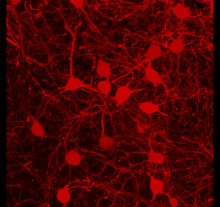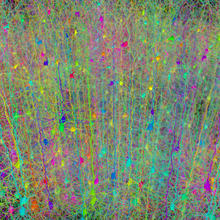
A neural network, also called a neuronal network, is an interconnected population of neurons (typically containing multiple neural circuits). Biological neural networks are studied to understand the organization and functioning of nervous systems.
Closely related are artificial neural networks, machine learning models inspired by biological neural networks. They consist of artificial neurons, which are mathematical functions that are designed to be analogous to the mechanisms used by neural circuits.
Overview
A biological neural network is composed of a group of chemically connected or functionally associated neurons. A single neuron may be connected to many other neurons and the total number of neurons and connections in a network may be extensive. Connections, called synapses, are usually formed from axons to dendrites, though dendrodendritic synapses and other connections are possible. Apart from electrical signalling, there are other forms of signalling that arise from neurotransmitter diffusion.
Artificial intelligence, cognitive modelling, and artificial neural networks are information processing paradigms inspired by how biological neural systems process data. Artificial intelligence and cognitive modelling try to simulate some properties of biological neural networks. In the artificial intelligence field, artificial neural networks have been applied successfully to speech recognition, image analysis and adaptive control, in order to construct software agents (in computer and video games) or autonomous robots.
Neural network theory has served to identify better how the neurons in the brain function and provide the basis for efforts to create artificial intelligence.
History
The preliminary theoretical base for contemporary neural networks was independently proposed by Alexander Bain (1873) and William James (1890). In their work, both thoughts and body activity resulted from interactions among neurons within the brain.

For Bain, every activity led to the firing of a certain set of neurons. When activities were repeated, the connections between those neurons strengthened. According to his theory, this repetition was what led to the formation of memory. The general scientific community at the time was skeptical of Bain's theory because it required what appeared to be an inordinate number of neural connections within the brain. It is now apparent that the brain is exceedingly complex and that the same brain “wiring” can handle multiple problems and inputs.
James' theory was similar to Bain's; however, he suggested that memories and actions resulted from electrical currents flowing among the neurons in the brain. His model, by focusing on the flow of electrical currents, did not require individual neural connections for each memory or action.
C. S. Sherrington (1898) conducted experiments to test James' theory. He ran electrical currents down the spinal cords of rats. However, instead of demonstrating an increase in electrical current as projected by James, Sherrington found that the electrical current strength decreased as the testing continued over time. Importantly, this work led to the discovery of the concept of habituation.
McCulloch and Pitts (1943) also created a computational model for neural networks based on mathematics and algorithms. They called this model threshold logic. These early models paved the way for neural network research to split into two distinct approaches. One approach focused on biological processes in the brain and the other focused on the application of neural networks to artificial intelligence.
The parallel distributed processing of the mid-1980s became popular under the name connectionism. The text by Rumelhart and McClelland (1986) provided a full exposition on the use of connectionism in computers to simulate neural processes.
Artificial neural networks, as used in artificial intelligence, have traditionally been viewed as simplified models of neural processing in the brain, even though the relation between this model and brain biological architecture is debated, as it is not clear to what degree artificial neural networks mirror brain function.
Neuroscience
Theoretical and computational neuroscience is the field concerned with the analysis and computational modeling of biological neural systems. Since neural systems are intimately related to cognitive processes and behaviour, the field is closely related to cognitive and behavioural modeling.
The aim of the field is to create models of biological neural systems in order to understand how biological systems work. To gain this understanding, neuroscientists strive to make a link between observed biological processes (data), biologically plausible mechanisms for neural processing and learning (neural network models) and theory (statistical learning theory and information theory).
Types of models
Many models are used; defined at different levels of abstraction, and modeling different aspects of neural systems. They range from models of the short-term behaviour of individual neurons, through models of the dynamics of neural circuitry arising from interactions between individual neurons, to models of behaviour arising from abstract neural modules that represent complete subsystems. These include models of the long-term and short-term plasticity of neural systems and their relation to learning and memory, from the individual neuron to the system level.
Connectivity
See also: Brain connectivity estimatorsIn August 2020 scientists reported that bi-directional connections, or added appropriate feedback connections, can accelerate and improve communication between and in modular neural networks of the brain's cerebral cortex and lower the threshold for their successful communication. They showed that adding feedback connections between a resonance pair can support successful propagation of a single pulse packet throughout the entire network. The connectivity of a neural network stems from its biological structures and is usually challenging to map out experimentally. Scientists used a variety of statistical tools to infer the connectivity of a network based on the observed neuronal activities, i.e., spike trains. Recent research has shown that statistically inferred neuronal connections in subsampled neural networks strongly correlate with spike train covariances, providing deeper insights into the structure of neural circuits and their computational properties.
Recent improvements
While initially research had been concerned mostly with the electrical characteristics of neurons, a particularly important part of the investigation in recent years has been the exploration of the role of neuromodulators such as dopamine, acetylcholine, and serotonin on behaviour and learning.
Biophysical models, such as BCM theory, have been important in understanding mechanisms for synaptic plasticity, and have had applications in both computer science and neuroscience.
See also
- Adaptive resonance theory
- Biological cybernetics
- Cognitive architecture
- Cognitive science
- Connectomics
- Cultured neuronal networks
- Parallel constraint satisfaction processes
References
- Hopfield, J. J. (1982). "Neural networks and physical systems with emergent collective computational abilities". Proc. Natl. Acad. Sci. U.S.A. 79 (8): 2554–2558. Bibcode:1982PNAS...79.2554H. doi:10.1073/pnas.79.8.2554. PMC 346238. PMID 6953413.
- Sterratt, D., Graham, B., Gillies, A., & Willshaw, D. Ch 9 (2011). Principles of Computational Modelling in Neuroscience, Chapter 9. Cambridge, U.K.: Cambridge University Press.
- Arbib, p.666
- ^ Bain (1873). Mind and Body: The Theories of Their Relation. New York: D. Appleton and Company.
- ^ James (1890). The Principles of Psychology. New York: H. Holt and Company.
- Cuntz, Hermann (2010). "PLoS Computational Biology Issue Image | Vol. 6(8) August 2010". PLOS Computational Biology. 6 (8): ev06.i08. doi:10.1371/image.pcbi.v06.i08.
- Sherrington, C.S. (1898). "Experiments in Examination of the Peripheral Distribution of the Fibers of the Posterior Roots of Some Spinal Nerves". Proceedings of the Royal Society of London. 190: 45–186. doi:10.1098/rstb.1898.0002.
- McCulloch, Warren; Walter Pitts (1943). "A Logical Calculus of Ideas Immanent in Nervous Activity". Bulletin of Mathematical Biophysics. 5 (4): 115–133. doi:10.1007/BF02478259.
- Rumelhart, D.E.; James McClelland (1986). Parallel Distributed Processing: Explorations in the Microstructure of Cognition. Cambridge: MIT Press.
- Russell, Ingrid. "Neural Networks Module". Archived from the original on May 29, 2014.
- "Neuroscientists demonstrate how to improve communication between different regions of the brain". medicalxpress.com. Retrieved September 6, 2020.
- Rezaei, Hedyeh; Aertsen, Ad; Kumar, Arvind; Valizadeh, Alireza (August 10, 2020). "Facilitating the propagation of spiking activity in feedforward networks by including feedback". PLOS Computational Biology. 16 (8): e1008033. Bibcode:2020PLSCB..16E8033R. doi:10.1371/journal.pcbi.1008033. ISSN 1553-7358. PMC 7444537. PMID 32776924. S2CID 221100528.
 Text and images are available under a Creative Commons Attribution 4.0 International License.
Text and images are available under a Creative Commons Attribution 4.0 International License.
- Liang, Tong; Brinkman, Braden A. W. (April 5, 2024). "Statistically inferred neuronal connections in subsampled neural networks strongly correlate with spike train covariances". Physical Review E. 109 (4): 044404. Bibcode:2024PhRvE.109d4404L. doi:10.1103/PhysRevE.109.044404. PMID 38755896.